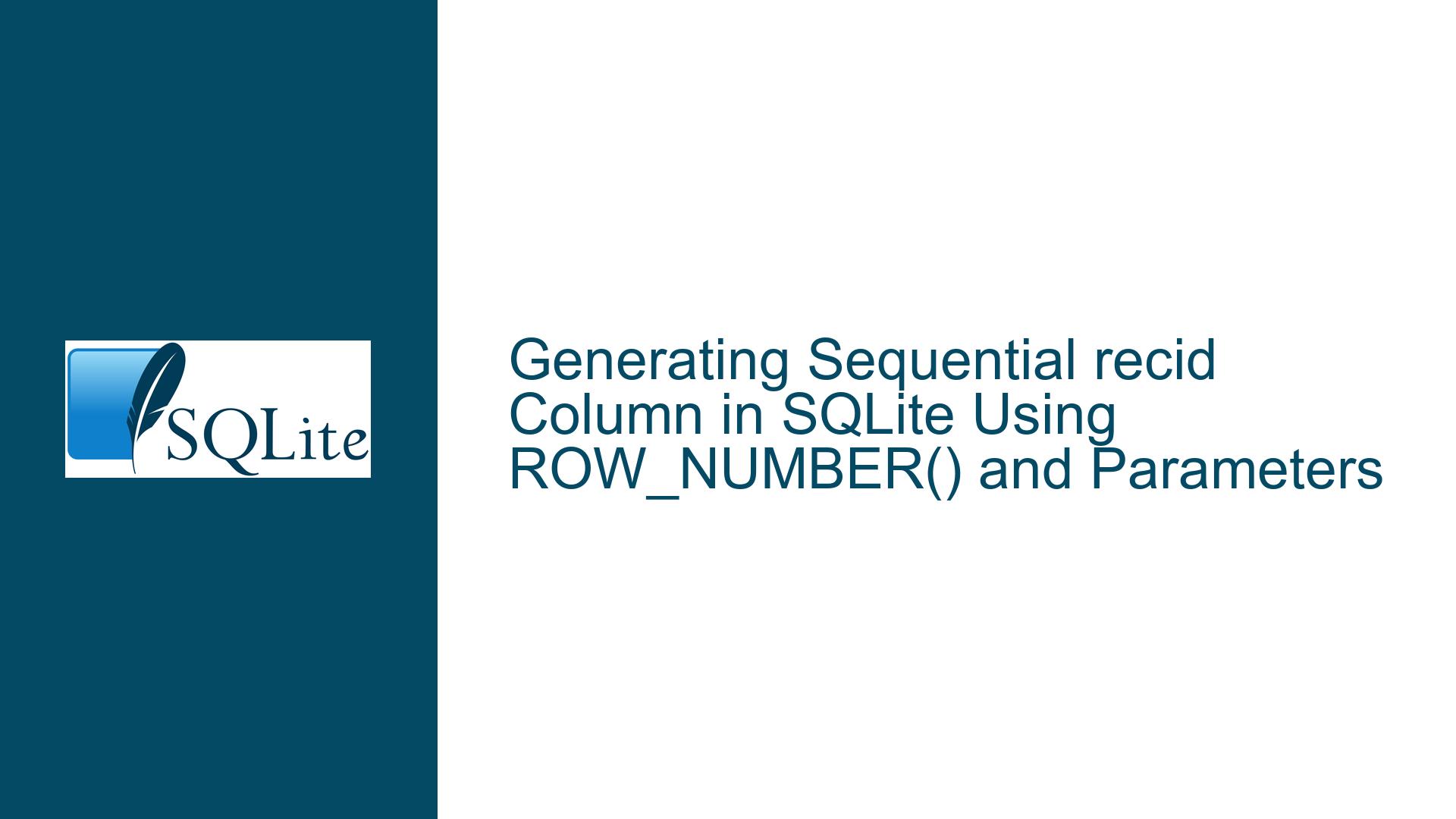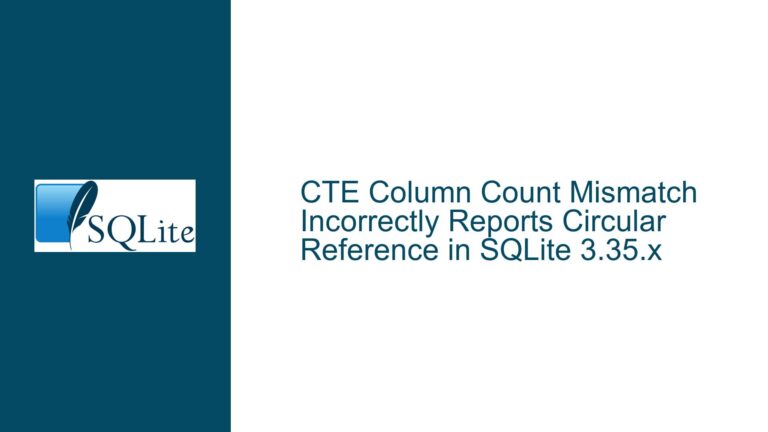Generating Sequential recid Column in SQLite Using ROW_NUMBER() and Parameters
Issue Overview: Sequential recid Generation During Table Creation
The core challenge involves creating a new table in SQLite with a synthetic column (recid) that acts as a sequential integer identifier. This column must start at a user-defined value (start) and increment by a specified interval (increment). The requirement mirrors functionality found in other database systems like Microsoft SQL Server’s IDENTITY or MySQL’s AUTO_INCREMENT, but SQLite lacks native syntax for such constructs.
The original approach proposed using a window function (ROW_NUMBER() OVER ()) to generate row numbers dynamically. A parameterized formula ((ROW_NUMBER() OVER ()) - 1) * :increment + :start was suggested to calculate recid values. While this works for basic scenarios, SQLite’s handling of window functions, implicit row ordering, and parameter substitution introduces nuances that affect reliability, performance, and correctness.
Key technical constraints include:
- Implicit Row Ordering: Without an explicit
ORDER BYclause in theOVER()window definition, the sequence ofROW_NUMBER()is non-deterministic. - Parameter Binding Limitations: SQLite’s inability to bind parameters directly in DDL statements (e.g.,
CREATE TABLE ... AS SELECT) forces workarounds for dynamicstartandincrementvalues. - Schema Preservation: Creating a table via
CREATE TABLE ... AS SELECTdoes not preserve primary keys, indexes, or constraints from the source table (myTable).
Possible Causes: Non-Deterministic Ordering and Parameter Handling
The primary causes of instability or incorrect recid assignment stem from three areas:
1. Absence of Explicit Ordering in Window Functions
The ROW_NUMBER() OVER () function assigns numbers based on the physical order of rows as stored in the database. However, SQLite does not guarantee stable row order across queries unless an ORDER BY clause is explicitly provided. For instance, after a VACUUM operation or row deletions, the physical storage order may change, leading to different recid values in subsequent table creations.
2. Static Parameter Substitution in DDL Contexts
The formula ((ROW_NUMBER() OVER ()) - 1) * :increment + :start uses named parameters (:increment, :start), but these cannot be bound dynamically in a CREATE TABLE ... AS SELECT statement. This forces users to hardcode values or employ string concatenation (as seen in the third reply using str_Low and str_Inc), which introduces SQL injection risks and complicates query construction.
3. Schema and Data Type Mismatches
When creating myNewTable via CREATE TABLE ... AS SELECT, SQLite infers column data types based on the result set. The recid column derived from ROW_NUMBER() (a 64-bit integer) may not match the expected INTEGER type, leading to compatibility issues with applications expecting 32-bit integers. Additionally, primary keys, unique constraints, and indexes from myTable are not carried over to myNewTable, potentially violating data integrity requirements.
Troubleshooting Steps, Solutions & Fixes
1. Enforcing Deterministic Row Ordering
To ensure stable recid values across table rebuilds or database maintenance operations, explicitly define row ordering in the window function:
CREATE TABLE myNewTable AS
SELECT
((ROW_NUMBER() OVER (ORDER BY (SELECT NULL))) - 1) * :increment + :start AS recid,
*
FROM myTable
ORDER BY rowid;
The ORDER BY (SELECT NULL) clause instructs SQLite to use the natural row order (equivalent to rowid ordering for tables without WITHOUT ROWID). Including ORDER BY rowid in the outer query further stabilizes the result set.
2. Dynamic Parameter Substitution Without String Concatenation
To avoid hardcoding start and increment values or using unsafe string concatenation, leverage temporary tables or scripting layers (e.g., Python, PowerShell):
Using Temporary Tables for Parameter Storage:
-- Create a temporary table to hold parameters
CREATE TEMP TABLE params (
name TEXT PRIMARY KEY,
value INTEGER
);
INSERT INTO params VALUES ('start', 1), ('increment', 2);
-- Use parameters in the main query
CREATE TABLE myNewTable AS
SELECT
((ROW_NUMBER() OVER (ORDER BY rowid)) - 1) * (SELECT value FROM params WHERE name = 'increment') + (SELECT value FROM params WHERE name = 'start') AS recid,
*
FROM myTable;
Scripting Layer Example (Python):
import sqlite3
start = 1
increment = 2
conn = sqlite3.connect('mydb.sqlite')
cursor = conn.cursor()
cursor.execute(f"""
CREATE TABLE myNewTable AS
SELECT
((ROW_NUMBER() OVER (ORDER BY rowid)) - 1) * {increment} + {start} AS recid,
*
FROM myTable;
""")
conn.commit()
3. Preserving Schema Integrity
To replicate the source table’s structure, including constraints and indexes:
Step 1: Create the new table with the desired schema.
-- Extract original schema
.schema myTable
-- Manually recreate with additional recid column
CREATE TABLE myNewTable (
recid INTEGER PRIMARY KEY,
col1 TEXT,
col2 INTEGER,
...
);
Step 2: Insert data with deterministic recid values.
INSERT INTO myNewTable (recid, col1, col2, ...)
SELECT
((ROW_NUMBER() OVER (ORDER BY rowid)) - 1) * :increment + :start AS recid,
col1,
col2,
...
FROM myTable;
Step 3: Recreate indexes and constraints.
CREATE INDEX myNewTable_col1_idx ON myNewTable(col1);
...
4. Handling Large Datasets and Performance
For tables with millions of rows, window functions may incur significant overhead. Optimize by:
- Using
rowiddirectly if the source table is aWITHOUT ROWIDtable. - Pre-sorting data and using temporary tables to lock in row order.
-- Materialize ordered data into a temporary table
CREATE TEMP TABLE myTable_ordered AS
SELECT * FROM myTable ORDER BY rowid;
-- Generate recid from materialized table
CREATE TABLE myNewTable AS
SELECT
((ROW_NUMBER() OVER ()) - 1) * :increment + :start AS recid,
*
FROM myTable_ordered;
5. Validating recid Uniqueness and Continuity
After table creation, verify that recid values are unique and follow the expected sequence:
-- Check for duplicates
SELECT recid, COUNT(*)
FROM myNewTable
GROUP BY recid
HAVING COUNT(*) > 1;
-- Verify sequence continuity
WITH gaps AS (
SELECT
recid,
LAG(recid) OVER (ORDER BY recid) AS prev_recid
FROM myNewTable
)
SELECT *
FROM gaps
WHERE recid - prev_recid <> :increment;
6. Addressing Edge Cases
- Zero-Based Increments: If
incrementis zero, the formula reduces to a constant value (start), violating uniqueness. Add a check constraint:CREATE TABLE myNewTable ( recid INTEGER CHECK (recid IS ((ROW_NUMBER() OVER (ORDER BY rowid)) - 1) * :increment + :start), ... ); - Negative Increments: SQLite allows negative increments, but ensure the
reciddoes not wrap into negative values unintentionally. - Concurrent Writes: If the source table (
myTable) is modified during theCREATE TABLE ... AS SELECToperation, useBEGIN EXCLUSIVE TRANSACTIONto lock the database.
7. Alternative Approaches Without Window Functions
For SQLite versions < 3.25.0 (lacking window function support), use a correlated subquery:
CREATE TABLE myNewTable AS
SELECT
(SELECT COUNT(*) FROM myTable t2 WHERE t2.rowid <= t1.rowid) * :increment + (:start - :increment) AS recid,
*
FROM myTable t1;
This method is less efficient but functionally equivalent for static datasets.
8. Integration with Application Logic
For dynamic recid generation outside SQLite, calculate values in the application layer:
# Python example
start = 1
increment = 2
cursor.execute("SELECT rowid, * FROM myTable ORDER BY rowid")
rows = cursor.fetchall()
for index, row in enumerate(rows):
recid = (index) * increment + start
cursor.execute("INSERT INTO myNewTable (recid, ...) VALUES (?, ...)", (recid,) + row[1:])
9. Migration Strategies for Existing Tables
To add a recid column to an existing table without recreating it:
-- Add column
ALTER TABLE myTable ADD COLUMN recid INTEGER;
-- Update with sequential values
UPDATE myTable
SET recid = ((ROW_NUMBER() OVER (ORDER BY rowid)) - 1) * :increment + :start;
10. Testing and Validation Framework
Automate validation using SQLite’s EXPLAIN and PRAGMA commands:
-- Explain query plan to ensure window function optimization
EXPLAIN QUERY PLAN
SELECT ROW_NUMBER() OVER (ORDER BY rowid) FROM myTable;
-- Verify table structure
PRAGMA table_info(myNewTable);
By systematically addressing ordering guarantees, parameterization, schema integrity, and edge cases, the recid column can be reliably generated in SQLite, emulating identity column behavior from other database systems.






